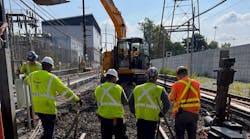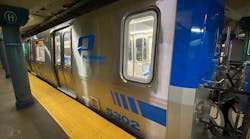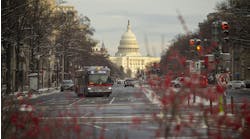PANYNJ releases proposed $9.4 billion budget
The Port Authority of New York and New Jersey (PANYNJ) has released the agency’s proposed $9.4 billion budget for 2025. The budget includes $3.6 billion of capital infrastructure investment spanning the redevelopment of the region’s major airports, the replacement of the outdated Midtown Bus Terminal, the rehabilitation of the George Washington Bridge, the modernization of the roadway network into the seaport’s busiest marine complex and the two-year initiative to overhaul the PATH commuter rail’s tracks, stations and signals.
The budget includes a proposal to add $0.25 to the toll rate for all vehicle classes in January 2025 beyond the automatic, inflation-based adjustments that occur annually. PANYNJ notes the adjustment will drive revenue increases needed to help address $3 billion in COVID-19 pandemic losses for the agency and inflationary pressures while supporting the largest PANYNJ capital investment in history, with progress at the agency’s bridges, tunnels, PATH, seaports and airports. In addition, the proposed budget includes two toll adjustments to incentivize non-E-ZPass users to enroll and to incentivize the proper use of E-ZPass transponders. The agency launched a major communications campaign to encourage E-ZPass enrollment and proper transponder use to benefit from lower E-ZPass rates.
The agency’s proposed $3.6 billion capital budget will target spending $750 million more than 2024 capital spending, as the agency completes several major capital projects such as the $2 billion Restoring the George program and the delivery of 72 new PATH railcars. PANYNJ will also undertake preliminary planning and substantial work to kick off its next set of priority projects, such as the multi-phase replacement of the Midtown Bus Terminal while continuing existing operations; the total replacement of the outmoded AirTrain Newark; and the implementation of the EWR Vision Plan to completely reimagine Newark Liberty International Airport after the successful opening of its Terminal A.
The proposed 2025 capital spending will fund:
- At John F. Kennedy International Airport, major construction progress on the supporting infrastructure for new terminals 1 and 6, as well as the rebuilding of the entire airport roadway network.
- The planning and design work needed to move forward on the EWR Vision Plan to transform Newark Liberty into a 21st century international gateway with a new on-airport mass transit system serving all terminals that will replace the existing AirTrain Newark that opened in the 1990s.
- The project to add pedestrian access from underserved Newark and Elizabeth communities to the Newark Airport Rail Link station, expanding mass transit and airport access for people in those communities seeking faster options to employment at the airport or in New York City via New Jersey Transit rail services or Amtrak.
- The remaining projects in the multi-year $2 billion Restoring the George program to replace or rehabilitate every major component of the 93-year-old George Washington Bridge, including all 592 of its suspension wires. Of the program’s 11 projects, four are complete and six are underway, with a final project undergoing preliminary planning.
- The start of early works construction for a new Midtown Bus Terminal, such as the platforms over the Lincoln Tunnel’s Dyer Avenue ramps and the start of work of a new bus staging and storage facility that will serve as the interim main terminal while existing bus terminal is demolished. The bus terminal replacement project will be constructed in phases to allow for the continued operation of the main terminal building and minimal disruptions to service for bus customers.
- Track infrastructure replacement, station rehabilitations, signal and equipment upgrades and new rail cars through the two-year $430 million PATH Forward program to improve speeds, service and reliability of the PATH commuter rail.
- The full implementation of PATH’s new tap-and-go fare payment system by the end of 2025, including replacements of existing SmartLink/MetroCard readers with new TAPP readers at all PATH stations and the introduction of a new TAPP card that will enable carryovers of existing SmartLink PATH fare discounts.
- Planning on a new express bus service for LaGuardia Airport, as well as the PANYNJ’s share of service and reliability improvements to Metropolitan Transportation Authority’s New York City Transit’s free-to-ride Q70 LaGuardia Link Select Bus Service.
- Support of campus-wide state-of-good-repair needs at the World Trade Center and upgrades of existing river water pump station.
“As this agency has done for more than 100 years, we are moving forward by planning and delivering infrastructure that can withstand the test of time and other changes from constantly evolving political and physical landscapes,” said PANYNJ Chairman Kevin O’Toole. “The lessons we have learned from recent challenges, from the economic and lifestyle changes wrought by the pandemic to the ever-increasing and devastating threats from climate change, have shaped our planning both for this agency and for this region. This budget reflects our response to those challenges and how we, as an agency, will move up and on to keep this region moving.”
PANYNJ notes that unlike similar agencies that operate and maintain critical infrastructure, it does not receive any tax revenue from the states of New York or New Jersey, as PANYNJ is a self-funded agency with revenue generated in part from third-party fees, rentals and other charges to businesses operating at its facilities. The agency says it works aggressively to generate maximal revenues from non-toll and non-fare sources.
While 65 percent of projected 2025 operating revenues will come from non-toll and non-fare sources, revenue changes from a package of toll and fare adjustments are proposed by the agency for implementation in 2025. PANYNJ notes the proposed adjustments are necessary:
- To address the negative impacts of the COVID-19 pandemic on revenues (loss of $3 billion over the 24-month period of March 2020 through March 2022) and operating costs.
- To continue to invest in the ambitious capital agenda for the agency’s tunnel, bridge, terminal and PATH facilities, as laid out in the 2017-2026 Capital Plan.
2025 toll and fare adjustment proposals
PANYNJ is posting for public comment a new proposed increase of $0.25 for autos, motorcycles and trucks to be implemented, effective Jan. 5, 2025. The proposal posted for public comment also recommends the board authorize $0.25 increases above the annual automatic inflation-based toll adjustments for autos and trucks in each of the next three years. The proposed adjustments preserve lower rates and discounts, including the Staten Island Bridges Plan.
Incentivizing E-ZPass usage and proper positioning of transponders
The proposals posted for public comment also contain two changes to existing toll rates that will affect only 10 to 15 percent of transactions:
- To incentivize enrollment in the E-ZPass program by drivers who are not yet enrolled by increasing the Toll-by-Mail (TbM) rate to a level consistent with the two-way TbM rate charged by the MTA at its bridges and tunnels ($22.38 for autos). The agency has proposed delaying the implementation date to July 2025 and engaging in an intense communications campaign to urge drivers to enroll in E-ZPass to take advantage of lower E-ZPass rates.
- To incentivize drivers who have enrolled in the E-ZPass program but whose transponders are not being read by the E-ZPass overhead gantry equipment, to ensure proper positioning of their transponders by introducing a new mid-tier toll rate for all classes ($18.72 for autos). The agency has proposed delaying the implementation date to July 2025 and engaging in an intense communications campaign to urge drivers to enroll in E-ZPass to take advantage of lower E-ZPass rates.
Implementing a PATH disability fare program
A new reduced fare program is also proposed for PATH riders with qualifying disabilities. Passengers who qualify under this program would pay the same reduced fare rate as a senior citizen or $1.50 per ride, effective once the new TAPP fare system is fully operational, which is estimated for summer 2025.
2025 automatic inflation-based toll adjustments
Bridge and tunnel tolls
Pursuant to the September 2019 Board action on bridge and tunnel tolls, an automatic inflation-based toll adjustment for autos and trucks occurs annually at the beginning of each calendar year. Based on the board-specified inflation adjustment, an automatic increase will occur, effective Jan. 5, 2025. The automatic board-mandated increase will raise the auto peak E-ZPass tolls by $0.43 and truck peak E-ZPass tolls by $0.58 per axle, effective Jan. 5, 2025.
PATH fares
Pursuant to the September 2019 Board action on PATH fares, an automatic inflation-based fare adjustment was triggered because the cumulative increase of CPI was greater than $0.25. PANYNJ says the board-mandated increase of the single ride fare from $2.75 to $3 will be effective on Jan. 12, 2025. All existing multi-trip and discounted fares will be maintained with appropriate adjustment. The single ride fare was last adjusted in October 2014, more than a decade ago.
PANYNJ says four public hearings have been scheduled at multiple locations across the region and at varying times of day so the public can give input on the budget.







